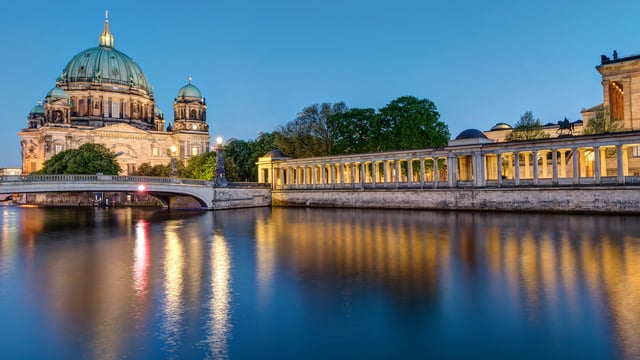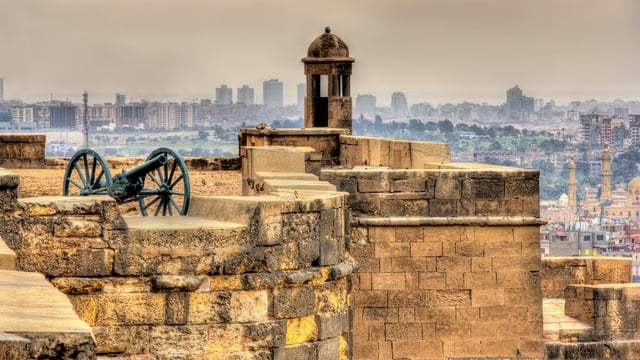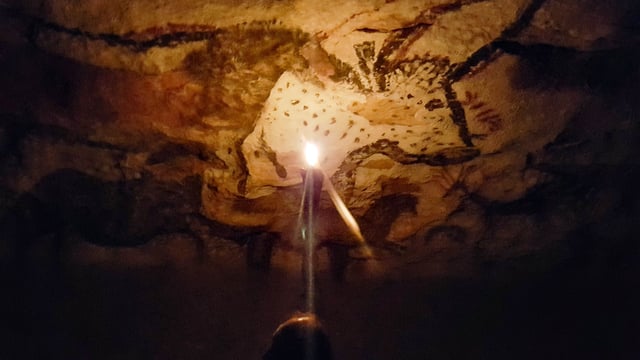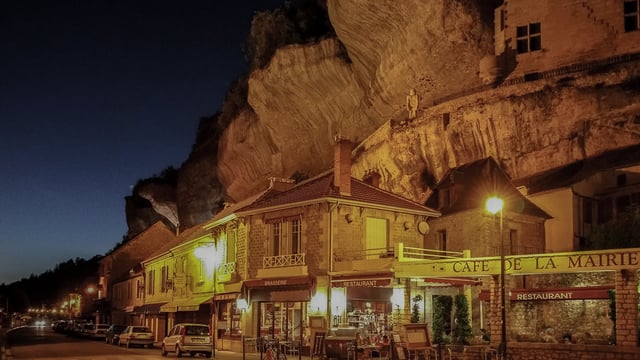Of all the many museums in Berlin, it is Museum Island (Museumsinsel in German) to which most visitors are drawn. From the delicate bust of the Egyptian Queen Nefertiti, to the extraordinary reconstruction of the Ishtar Gate from ancient Babylon. From a 6th century mosaic from Ravenna to French Impressionist paintings. The diverse collections exhibited on Museumsinsel are of international significance. Whether you want to visit only one or two, or explore as many museums as you can on Museum Island and beyond, there are a number of ticketing choices available. From single entry tickets to museum and city passes. Having tested most of them, I weigh up your options.
- Thomas Dowson
- Last Checked and/or Updated 15 December 2021
- No Comments
- Berlin, Germany Travel Tips, Travel Tips
Museumsinsel
The northern section of the island in the Spree River, as it flows through the Mitte district of Berlin, is known as Museumsinsel. Today it is home to five of the most outstanding museums in Berlin, the Berliner Dom and the Humboldt Forum, Museumsinsel’s newest museum and cultural centre. Together these museums display collections of prehistoric artefacts to the objects of 19th century, from many areas throughout the world.
The James-Simon-Gallerie acts as the visitors centre as well as the space for temporary exhibitions.
The Altes Museum was the first to be erected. Early in the 1800s King Friederich Wilhelm III of Prussia decided that the royal collection of ancient art should be on public display. Designed by Karl Friederich Schinkel, the Königliches Museum was opened in 1830. In 1841 it was renamed when Friederich Wilhelm’s son declared the island an area of art and science, and the Neues Museum was constructed. With development ongoing to enhance the visitor experience, there is just under 200 years of museum architecture on the island.
During the early stages of World War II, the collections left the island for safety. After the war, and following the division of Berlin, so too were the collections divided. Museumsinsel was located in East Berlin, but had suffered significant damage during World War II. Some of the museums were restored, but it was not until the unification of Germany did all artefacts return to Museumsinsel. There followed a significant re-organising of the collections and exhibitions, as well as a substantial programme of renovation and development.
Four of the five museums will be connected by an ‘archaeological promenade’. Located at the basement level of each museum, this promenade will not only physically connect the great archaeological collections of these museums, but it will also provide a thematic connection between the collections displayed in these museums. The idea of connecting the museums and their collections was part of the original plans for the island dating back to the mid 19th century. The physical bridges and walkways were so destroyed during World War II that they were demolished and not rebuilt. In 1999 during the creation of a new master plan, the idea of creating connections via basements was developed. Parts of this promenade are still under construction.
So significant are the collections and indeed the buildings in which they are exhibited, Museumsinsel was added to the UNESCO list of world heritage sites in 1999.
Buying a single entry, skip-the-line ticket for each of the museums is possible. Also, a number of passes, from one day to three days, can be purchased in advance, online.
Altes Museum
The Altes Museum was the first of the five museums, built between 1823 and 1830. The building is itself an important example of Neoclassical architecture. The entrance of sweeping steps leading to 18 monumental columns and on to a grand staircase and the rotunda based on the Pantheon in Rome. These are architectural features that were until this period reserved for the residences of royal palaces.
Exhibitions are spread over two floors. The first floor has 12 galleries displaying art from ancient Greece beginning with the 10th century BC and ending with the 1st century BC. On the second floor are eight galleries displaying Etruscan and Roman Art. The collection of Etruscan objects is the largest outside of Italy. Do not miss the striking Green Caesar and Cleopatra.
The final gallery has a wonderfully innovative display of the history of the Classical Collection on display in the Altes Museum.
On display in the Altes Museum houses are the Staatliche Museen zu Berlin’s Collection of Classical Antiquities (Antikensammlung), which includes Greek, Etruscan and Roman art, and the collections of antique coins, Numismatic Collection or the Münzkabinett.
Buying Skip-the-line Tickets for the Altes Museum
The price for the Altes Museum for one adult is €10. This can be purchased online, in advance at no extra cost – giving you entry to the Altes Museum. These tickets can be cancelled up to 24 hours in advance for a full refund.
Alte Nationalgalerie
The Nationalgalerie is one of the most significant collections of the State Museums in Berlin, a collection of artworks from 1800 to the present day. This collection is on show at several locations around Berlin; the 19th century is housed in the Alte Nationalgalerie on Museumsinsel. The museum was built between 1867 and 1876 with a mix of late Classicism and early Renaissance styles. The main features of the building – the church-like apse, the theatrical grand staircase and overall look of a Roman temple – were used to show that there was a unity of art, nation, and history. History and nation is further alluded to with the equestrian statue of Frederick William IV at the top of the stairs, while inside the staircase you can see a frieze depicting principle figures of German history from prehistoric times to the 19th century.
Artworks are displayed over three levels, the first exhibits Classical sculpture, the second Idealism, Realism and Impressionism, and the third Neo-Classicism and Romanticism.
Buy Skip-the-line Tickets for the Alte Nationalgalerie
Bode-Museum
Built between 1887 and 1904, the Bode-Museum was until 1956 known as the Kaiser-Friedrich-Museum. Initially intended to house the Gemäldegalerie – the collection of Old Master paintings – and sculptures of the Christian era. Although some ‘Old Masters’ remain in the museum, the Gemäldegalerie is now located at the Kulturforum.
Three major collections of the State Museums in Berlin make up the galleries in the Bode-Museum. The Skulpurensammlung, which includes the largest collection of sculpture in existence from the Middle Ages to the 18th century and includes works by Donatello, Tilman Riemenschneider and Antonio Canova. The Museum of Byzantine Art has an extraordinary range of Late Antiquity and Byzantine art, from the 3rd to the 15th centuries. And finally, the Numismatic Collection has over 4,000 coins and medallions, the oldest from the 7th century BC to currencies of today.
Buying Tickets for the Bode Museum
The price for the Bode Museum for one adult is €10, which can be purchased online, in advance. Buying your ticket via GetYourGuide allows you to cancel your booking for a full refund up to 24 hours before your reserved date – with no fee. Buy your Bode Museum Tickets. These are not designated skip-the-line tickets, but rarely if ever are there queues for this museum.
Neues Museum
Neues Museum was the second museum on Museumsinsel, having been built between 1843 and 1855. The building is considered a major landmark in 19th century museum construction and technology, applying building techniques made possible by industrialisation, such as the use of a steam engine to sink pilings into the river bed for the buildings foundations. Although partly destroyed during the second World War, other museums with similarly Neoclassical and ornate interiors, the Glyptothek and Alte Pinakothek in Munich, were much more severely destroyed in World War II. The Neues Museum then gives us one of the last remaining chances to see German interior museum layout from the 19th century. Initial restoration was carried out in the 1980s, but the most substantial renovation and refurbishment took place between 2003 and 2009, under plans from the British architect David Chipperfield.
Spread over 4 levels are displays from Scandinavia to North Africa, from the Atlantic to the Middle East; from prehistory to the Middle Ages. Perhaps one of the most well known artefacts is the bust of Nefertiti, but there are many other equally striking objects, including the Bronze Age ‘Berlin Golden Hat’, the Xanten Youth, and Berlin Green Head. Amongst the oldest is the Neanderthal skull from Le Moustier near Les Eyzies in the Dordgne (France).
The displays in the Neues Museum draw on the Staatliche Museen zu Berlin’s Egyptian Museum and Papyrus Collection, the Museum of Prehistory and Early History (the Museum für Vor- und Frühgeschichte) and the Collection of Classical art.
Buying Skip-the-line Tickets for the Neues Museum
The price for the Neues Museum for one adult is €12 on entry. Skip the queues at the tickets desks and, at no extra cost, buy your ticket in advance, online. Should you need to cancel your reservation, you can do so and get a full refund up to 24 hours in advance without paying a cancellation fee.
Pergamon Museum
The Pergamon Museum is the most recent of the five museums to have been built on Museumsinsel, between 1910 and 1930. When constructed three wings in a U-shape housed three collections of the State Museums in Berlin. They are the Collection of Classical Antiquities, the Museum of the Ancient Near East and the Museum of Islamic Art. The Museum is currently undergoing major refurbishment, the U-shape being closed with the addition of a fourth wing. The Pergamon is well known for its reconstructions of monumental buildings.
Two of the monumental structures in the Classical collection are the Pergamon Altar and the Market Gate of Miletus. The altar is not accessible to the public while building proceeds, a tentative date of 2023 has been given for the re-opening of the Pergamon Altar gallery.
Over 6 millennia of Near Eastern history is covered with some 500,000 artefacts. Most of these obtained for the collection by German archaeologists working at the important sites of Babylon, Assur, Uruk and Tell Halaf. The highlight of this collection is the reconstruction of the Ishtar Gate and Processional Way.
The collection of artefacts in the Museum of Islamic Art is one of the largest in the world. On display are artefacts from the 7th to the 19th century, the highlight of which is a portion of the façade from the caliphate palace of Mshatta.
Buying Skip-the-line Tickets for the Pergamon Museum
The price for the Pergamon Museum for one adult is €12, this does includes the Pergamon 360° Panorama Experience. That is a further €12.
At no extra cost, you can purchase skip-the-line tickets for both: Pergamon Museum and the nearby Pergamon 360° Panorama Experience.
With both of these tickets, you can cancel your reservation and get a full refund up to 24 hours in advance, with paying a fee, at the time of booking or cancelling.
Tickets and Passes That Include All Five Museums
Besides the usual city passes available, there are a couple of passes available for visitors to Berlin who want to see as many of the museums on Museumsinsel as possible. The difference between these passes is how much time you want to spend; one day or three days.
One-day Museuminsel Pass
If you only have one day and want to see 2 or more of these museums, then this is the ticket for you. For only €19€ this one-day pass gives you entry to all five of the museums, plus the Pergamon 360° Panorama Experience.
Tickets for Museum Island Berlin + Pergamon 360° Panorama
All you have to do is visit at least two of the museums and you have covered your cost. Visiting all five in a day can be done – but you will be only looking at highlights. On my second visit to Museum Island I did get to see all five in one day. It was a long day, but even with a short lunch break it was doable.
Instructions for this ticket state you can only skip the line for the Altes Museums, the Altes Nationalgalerie and the Bode Museum. That you have to get in the queue at the ticket desks for the Neues and Pergamon Museums to get a timed entry. Tip: I waited for the end of the day for these two museums, and did not have any problems getting in. If you are visiting at a busy period, I recommend going to the two ticket desks and booking your time-slot for the Neues and Pergamon before setting off to see the others.
Berlin Welcomecard 3-day Museum Island Pass
If you want to spend longer exploring the Museumsinsel museums, and you have more than one day to do this, then there is a Berlin WelcomeCard that is specifically for Museum Island.
The card is available for three days and includes public transport for 72 hours. If you choose transport zones A and B the cost is €55, if you need all three zones (A, B and C), then the cost is €59. For each of the three consecutive days you get admission to the five museums once. You also get discounted admission to special/temporary exhibitions. And there are many discounts to be had at partner attractions (these are all detailed in the information you will receive).
Berlin WelcomeCard: Museum Island & Public Transport
Buy your card in advance, online via GetYourGuide. Should you need to cancel your reservation for whatever reason, you can do so and get a full refund up until 24 hours in advance, without paying a cancellation fee.
What About the Standard Berlin Welcomecard?
Berlin has quite an extensive WelcomeCard for any where between 2 and 6 days. Each card comes with a substantial guidebook. And besides discounted entry to Berlin’s varied activities, attractions and museums (over 200 of them), each card also includes unlimited travel on all forms of public transport in the city – including trams, the S and U-Bahn networks and buses.
There are two choices for transport needs. Cards are available covering transport in either zones A and B, or A, B and C). The card covering Zones AB is available for 3, 5 or 6 days. The card covering ABC zones is available for 2,3,5 or 6 days. To give an idea of prices, as of September 2021, a 48 hour card for zones ABC costs €28 per person. A six day card with zones AB included costs €47.
Berlin’s WelcomeCards are very good cards. They cover a wide range of activities and attractions. Besides the transport benefit, they offer discounted entry to the participating attractions. In some cases up to 50% discounts. My feeling is they only work the longer the period. It is very easy to recover your costs for a five or six day card. Less so for a two or three day card – for which you will be rushing around.
More importantly, these WelcomeCards do not include the five museums on Museumsinsel. A five or a six day card may work with the Museumsinsel day pass mentioned above for €19. If Museumsinsel is not on your list, and you are sightseeing in Berlin for about five or six days, then I would definitely consider a Berlin WelcomeCard. But remember they are discount cards. See more details of what is included and book online:
Berlin WelcomeCard Inner City Transport AB & Discounts
Berlin WelcomeCard Transport ABC & Discoounts
Berlin & Museum Island – Which Card or Pass for 2021?
Having a number of different options for visitors to Berlin is a good thing. After all, a one-size-fits-all approach would not work. And that is why finding the right tickets/card/pass for you requires forethought and planning. Otherwise you will run the risk of not having the ticket you need and end up paying more than is necessary. Good for business, not good for you! Having tried all the options, the only two passes I consider for Berlin in general (besides the Museumsinsel tickets and passes) are the Berlin WelcomeCard and the Berlin Pass. All others are simply selling the WelcomeCard with their own branding.
As with all city cards and passes, there is no one right answer to the obvious question ‘which is the best pass to get for Berlin?’ The card that is right for you will almost certainly not work for the next reader of this page. Everyone wants to see and do different things. And this is why information on the various forums and discussion groups around the internet appears to be contradictory. Its not that the information is wrong, but rather that people are basing their opinions on limited experience, having bought one ticket for their own needs. If they did not research their pass sufficiently, it was doomed to fail from the start, and the pass is branded useless for everyone.
STOP reading other reviews now. Decide what you want to do, and work out which of the options presented above suits your needs.
For example, on one two-day visit to Berlin all I wanted to do was visit a temporary exhibition in the Neues Museum and see as much as I could on Museum Island and in the city centre thereafter. For this I chose to stay at the nearby Radisson Blu Hotel, so no transport costs other than getting to and from the airport. The 3-Day Museum Pass at €29 and an extra charge for the temporary exhibition was all I needed. None of the other cards would have been worth my while.
This scenario will certainly not appeal to many. For instance you might not have accommodation that close to the city centre, in which case you would need to add the cost of transport. You might want to see and do much more than the five museums on Museum Island. If you are staying for five days, you might want to consider a day-trip further afield, I recommend Potsdam. In this example, perhaps the Berlin WelcomeCard for 5 days with Transport for A, B and C zones and the 1-Day Museumsinsel Pass would be better suited.
Obviously I can not set out out each and every scenario, but each ticket does have the potential to save both time and money. For you to work out whether they are value for money, you need to look at what you want to see and do, and match that with the different options and their respective restrictions. That said, I offer a few observations based on my experience of these cards and passes.
Berlin Welcomecard Vs the Museum Island Welcomecard?
The Museum Island Welcome Card includes ‘free’ entry to the five museums on Museuminsel and lasts for three days. The equivalent, three-day basic Berlin Welcome Card does not include these museums. Both come with the same transport options (i.e. zones A & B and A, B & C). The difference in price between the two (as of April 2019) is €17, but the benefits of the Museumsinsel version are definitely worth more than that. For example, it costs €19 to get into the Pergamonmuseum.






